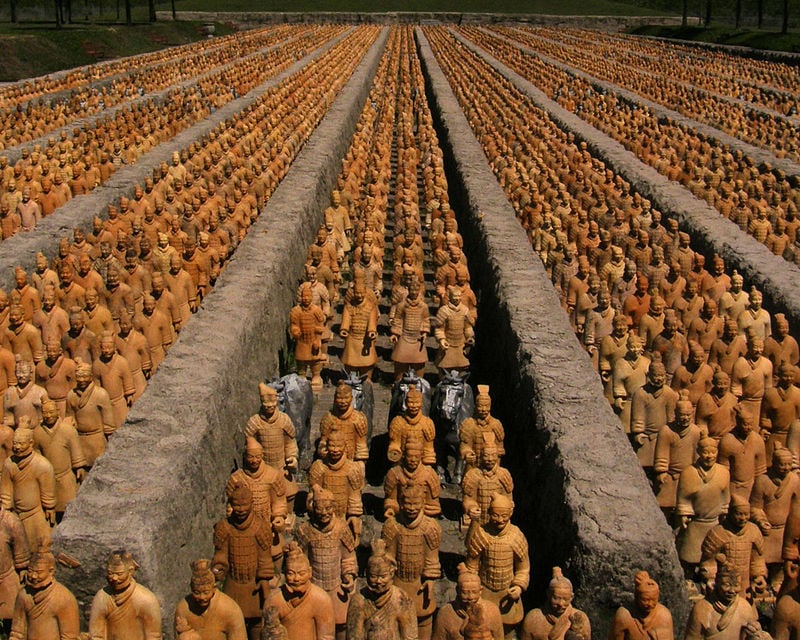
The Terracotta Army is one such mystery that historians and excavators are trying to unravel. Apparently, what you see is hundreds of life-size replicas of soldiers, horses, and chariots in a war formation
Mystery and history always find takers. The Terracotta Army is one such mystery that historians and excavators are trying to unravel. Apparently, what you see is hundreds of life-size replicas of soldiers, horses, and chariots in a war formation, but a more probing look takes you more than 2,200 years back when China had just become a unified empire. This mausoleum-turned-museum of the first Emperor of unified China – Qin Shi Huang – is suggestive of country’s commitment to preserving history.
History
These terracotta sculptures depict the army of Emperor Qin Shi Huang. These figures date back to 3rd century BC and it is believed that this army was built to protect the king in his afterlife. In 1974, the sculptures were discovered by farmers in Lintong district of Shaanxi province.
Things to Do in Museum of Qin Terracotta Warriors and Horses
The Museum of Qin Terracotta Warriors and Horses, which came into existence in 1975, has three vaults and The Exhibition Hall of the Bronze Chariots covering an area of 16,300 sq. m. The first vault is not only the largest but also the first to be unveiled before the public. There are terracotta figures of warriors at the front and they are followed by war chariots at the back.
As you move on to the second site, which is about 20 meters northeast of the first one, you come across a thousand warriors and 90 chariots of wood. This part of the museum was opened to the public in 1994. Few meters northwest of the first site lies the third vault that resembles a command center of the armed forces. The tallest figures of warriors, especially the generals and officers, are displayed along with a war chariot, and four horses.
Theses sites collectively have 7,000 terracotta soldiers, horses, chariots, and weapons. As you explore the exhibition hall, the restored bronze carriages catch your attention. Discovered in 1980, these carriages are completely made of bronze with 1,720 pieces of golden and silver ornaments.
Terracotta Army Facts
- The site of Terracotta Warriors is considered the largest preserved mausoleum in China.
- Each terracotta soldier seems to have unique facial features. It reflects stellar craftsmanship and artistry of those days.
- Even four decades after its discovery, not even one per cent of Emperor Qin Shi Huang’s tomb has been excavated.
- When archeologists discovered around 40,000 bronze weapons, including battle axes, crossbows, and spears, they looked very well preserved.
- In December 1987, UNESCO selected the place as a World Cultural Heritage Site.
- 120 objects from the mausoleum and 20 terracotta warriors were displayed at the British Museum in London from September 13, 2007 to April 2008, and eventually, the year 2008 turned out to be the British Museum’s most successful year. Read to know more interesting facts about Terracotta Warriors
Nearby Attractions
There are significant number of places close to the museum that are worth exploring. Xian, one of the emerging mega cities in China, is known for The Giant Wild Goose Pagoda and Small Wild Goose Pagoda. These towers are more than 1,000 years old and they have miraculously survived major earthquakes.
The City Wall of Xian, the world’s largest city wall, is worth a visit, especially if you want to know about one of the largest military defensive systems in the ancient world.
The Stele Forest is famous for the impressive stoneworks and historic inscriptions .
Daming Palace National Heritage Park houses the well-preserved ruins of the Tang Dynasty. The natural pond within the complex offers plenty of recreational features.
Location of Museum of Terracotta Army
The museum of Terracotta Warriors is in Lintong district of Xian in Shaanxi province. The site is about 40 km from the central hub of Xian.
Location Map of Terracotta Army, China
How to Reach?
By Air – Xi’an Xianyang International Airport is the major airport connecting Xian with the rest of the world. The airport is an hour’s ride from the Terracotta Army museum.
By Rail – There are good number of trains connecting Xian with several cities in China including Beijing, Chengdu, Chongqing, Guangzhou, Lhasa, and Shanghai.
Accommodations
While Hyatt Regency, Sheraton Hotel, Garden Hotel, and Kempinski Hotel are some of the best luxury hotels in the town, the options for mid-range hotels also go beyond Citadines Central, Grand Mercure, and Nanlin International Hotel. Those who are on a shoestring budget can choose from any of the International Youth Hostels located right in the city center.
Restaurants
Tong Sheng Xiang Restaurant and the Lao Mi Jia are best known for their signature dish – Yang Rou Pao Mo. While Rong Palace serves authentic Chinese cuisine, the food joints in the Muslim Quarter are also nice options.
Best time to visit the Terracotta Army
Spring and autumn are considered the best seasons to visit this ancient site.
Things to Remember
It usually takes a half day to explore the exquisite artifacts that testify the military, cultural, and economic history of the Qin Dynasty. It’s recommended to visit the site in early afternoon to avoid the crowds.
Entrance Fees
March to November: General – ¥150 ($24), Students – ¥75 ($12)
December to February: General – ¥120 ($19), Students – ¥60 ($9.5)
Entry Timings:
March to November: 08:30 AM to 17:30 PM
December to February: 08:30 AM to 17:00 PM
Related: Shanghai Travel Information | Forbidden City In China
Image Credit: Vybr8
